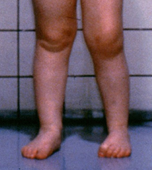Paediatric rheumatology
The commonest musculoskeletal problems faced by children and adolescents relate to soft-tissue pain, and this is usually from being hypermobile (i.e. a range of joint movement in excess of the normal for most people of that age). Adaptations such as orthotic insoles and some splints can be very useful, but the mainstay of managing hypermobility is exercise under the care of an experienced physiotherapist.
Children and adolescents do develop inflammatory arthritis (Juvenile Idiopathic Arthritis – JIA) which is similar to RA, but with some subtle differences. JIA is about as common as juvenile diabetes. The introduction of the same drugs as are used for adults with inflammatory arthritis has drastically improved the wellbeing and long-term prognosis for children with JIA.
As the photo shows, this child’s left knee is swollen and will not straighten. If left untreated, the affected limb with grow longer than the normal one, then stop growing early and end up shorter than the normal limb, causing further bio-mechanical problems.
Certain types of JIA can be associated with painless inflammation in the eye (Anterior Uveitis) which can affect the child’s eyesight and needs to be screened for by an Ophthalmologist if suspected clinically.
